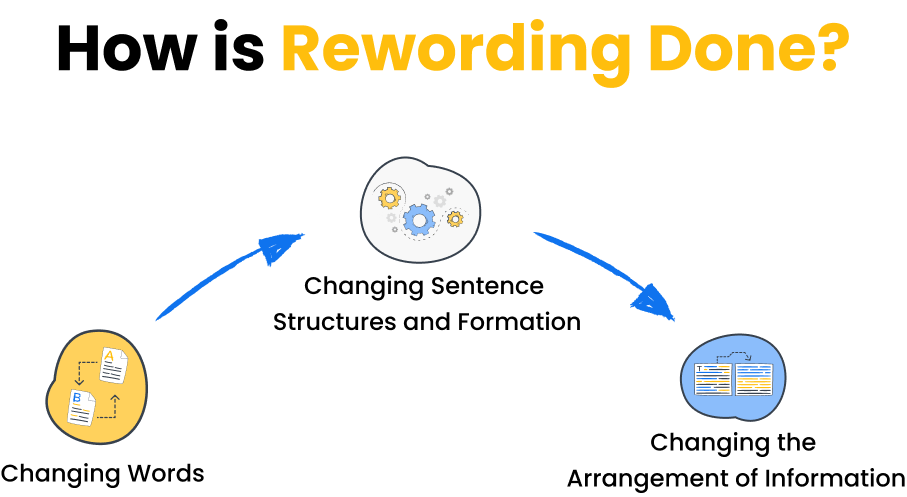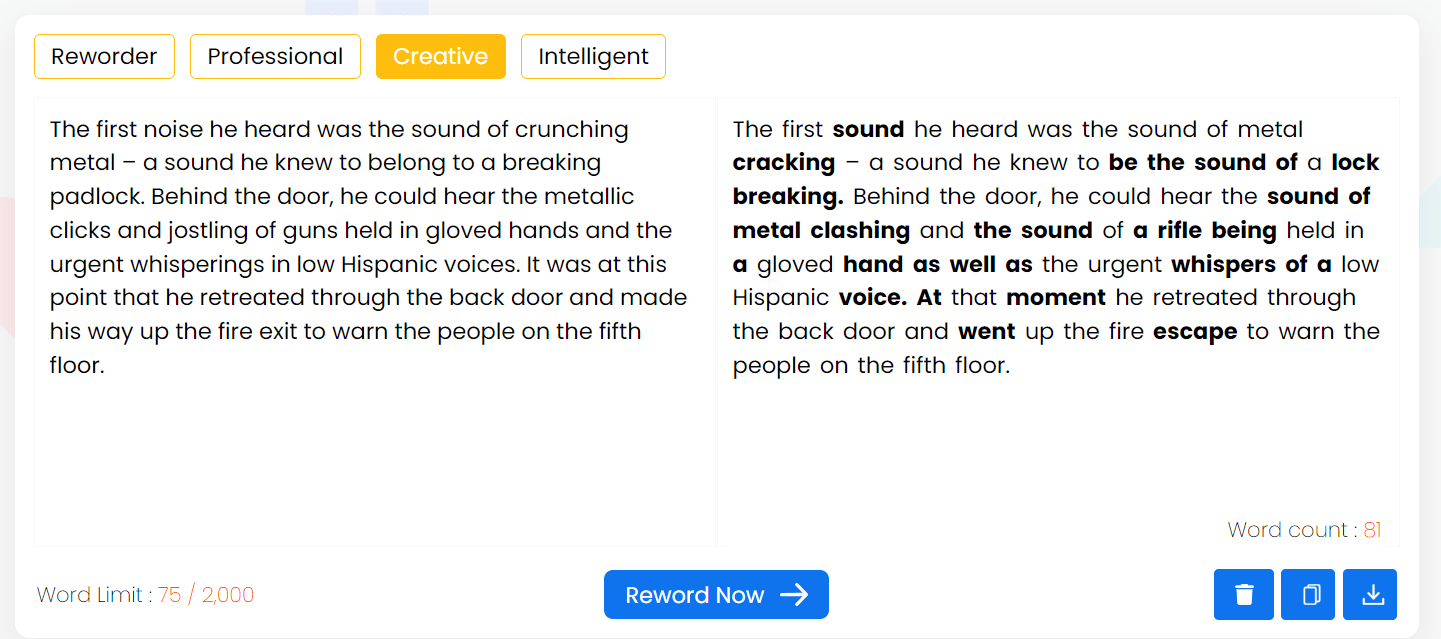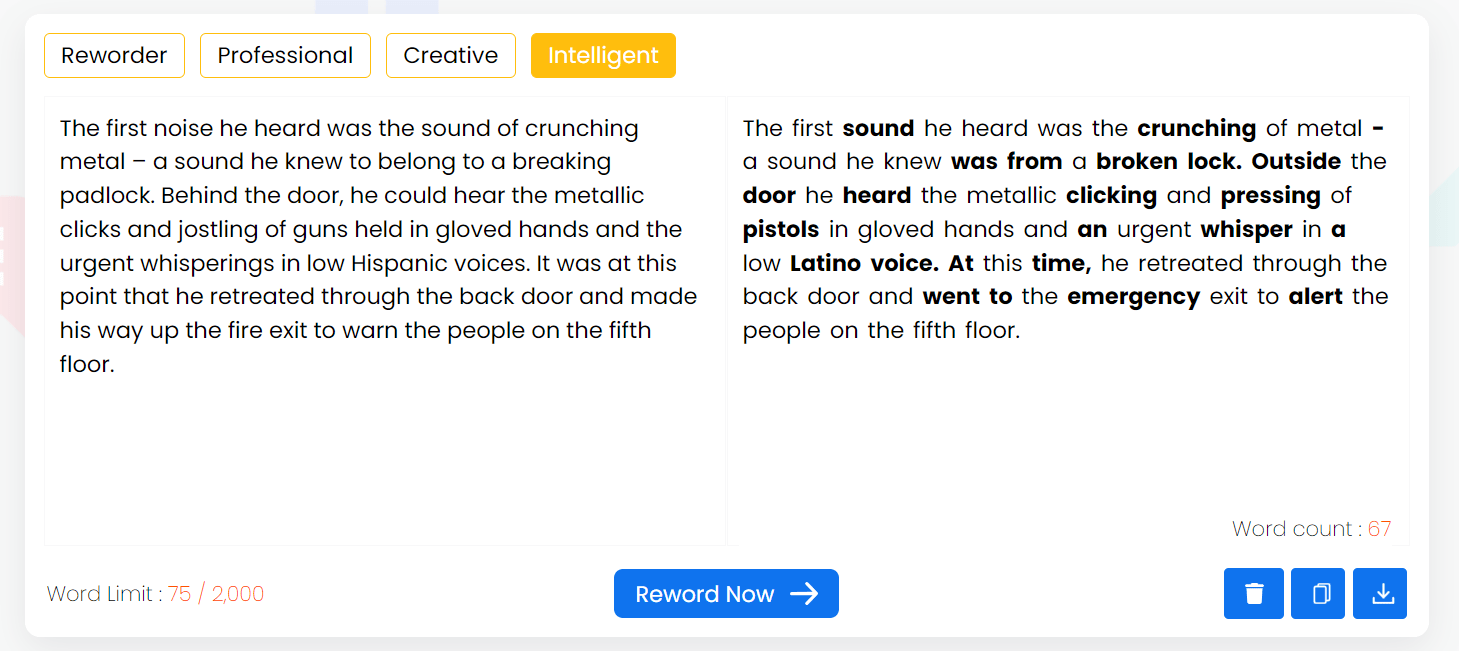
Rewording is a popular writing technique that is used for many different purposes. It has to be done in a very specific way with different considerations. When done incorrectly, it can pose problems and issues. That is why it is important to know exactly how it is done.
If you are trying to learn how rewording is effectively done on a piece of text, it can be helpful to look at a few examples that show the process in action.
In this blog post, we are first going to see what rewording is and how it is done, and then we will look at some examples.

Rewording is basically a synonym for paraphrasing. They both mean the same thing.
The process in which a piece of content is reworded and restated using different words and phrases than what it originally contained.
There are a couple of different imperative conditions that the changes made have to follow in order to qualify as “rewording” and not some other writing technique.
Related topic: Rewording Guide

Now, let’s take a look at how rewording or paraphrasing is done.
The process generally involves the implementation of various changes that collectively alter the content enough to make it look different from its original form. These changes are:
These types of changes can be made to the text manually, i.e., by a person, or they can be made with the help of an online rewording tool.

Now, we will move on to look at some examples of rewording to show you how the process is actually done. In the section above, we have highlighted different types of changes that it usually involves. In the examples below, we will illustrate each of these changes one by one.
For this example, we will write a random passage and then reword it manually to give you an idea of what the process looks like action:
The first noise he heard was the sound of crunching metal – a sound he knew to belong to a breaking padlock. Behind the door, he could hear the metallic clicks and jostling of guns held in gloved hands and the urgent whisperings in low Hispanic voices. It was at this point that he retreated through the back door and made his way up the fire exit to warn the people on the fifth floor.
Now, we will manually reword this content, and our focus is on demonstrating the “rewording” change, i.e., adding synonyms in place of the original words.
The first disturbance he heard was the noise of wrenching metal – a sound he knew to belong to a dismantling padlock. Behind the door, he could hear the metallic clicking and movement of guns held in gloved hands and the quick whisperings in low Hispanic accents. It was at this point that he went through the back door and made his way up the emergency staircase to warn the individuals on the fifth floor.
In this example, you can see that the only changes made to the text are synonym-replacement. There are no other alterations like changes to the sentence structures, etc.
In this example, we will look at the “restructuring” that we discussed in the section above. We won’t make any other changes. Here is the passage that we will be using for this purpose:
The fifth floor, much to his surprise, was completely empty. It was eerie, but it also explained why a break-in was in the process of being enacted. Someone had tipped off the silent hours of the precinct. As he looked through the window into the bullpen, he saw something move out of the corner of his eye. Someone was there, but they were hiding under a desk.
If we restructure these sentences, they would come out looking something like this:
Much to his surprise, the fifth floor was completely empty. It explained why a break-in was in the process of being enacted, and it was eerie. The silent hours of the precinct had been tipped off. He saw something move out of the corner of his eye as he looked through the window into the bullpen. They were under a desk, but someone was there.
It has to be kept in mind that this is a technique to augment the rewording process. It’s not rewording on its own.
In the example above, you can see that the sentence structures have been changed, but the words used are still the same.
In this next example, we will look at the “rearranging” change that we talked about. One thing to note about this type of change is that it is not easy to apply in all situations, and it has to be very carefully done.
Here is the passage that we will be using for this:
The rain fell in a steady rhythm, each drop tapping out its own sad tune. He stood alone on the dimly lit street, the glow of neon signs reflecting off the wet pavement. Somewhere in the distance, a car engine roared to life, its growl cutting through the night. He pulled his coat tighter around him, steeling himself for what lay ahead.
And here is what the rearranging bit looks like:
Somewhere in the distance, the growl of a car engine roaring to life cut through the night. He stood alone in the dimly lit street as the rain fell in a steady rhythm, each drop tapping out its own sad tone. The glow of the neon signs reflected off the pavement as he pulled his coat tighter around him and steeled himself for what lay ahead.
In the example above, you can see that the words used are the same. The sentence structures themselves are not that varied. However, the arrangement of the sentences in the passage itself has been changed. The sentence that comes second in the original passage is what starts off the passage in the example.
With all this, the meaning of the overall passage is the same.
So far in this blog, we have looked at examples of rewording by doing it ourselves manually. However, nowadays, there is a quicker alternative to this method – and that is to utilize an AI reworder.

We will now look at a few examples of how rewording is done using this method.
For one of the examples, we will use some sample text and reword it using our “Creative” mode. You can see the output in the image below.

When you’re using Rewording Tool, different changes are collectively made to the text. There is a bit of synonymizing going on along with changes to the sentence structures and everything.
That is what you can see in the image above.

Here is what Rewording Tool does to the same content in the “Intelligent” mode.
And that wraps up this post.
The purpose of giving all these examples was to help you understand how the process of rewording is done. We talked about the different changes that are made during the whole process, and then we demonstrated those using various examples.
Hopefully, after reading this post, you will have a better idea of how to reword content the next time the need arises.